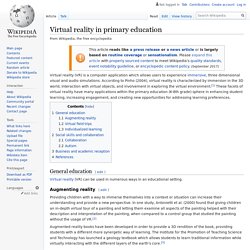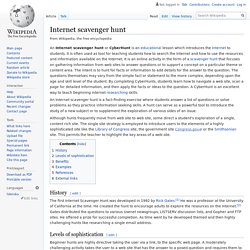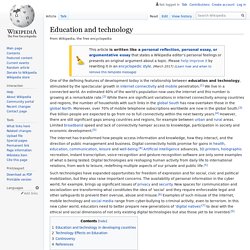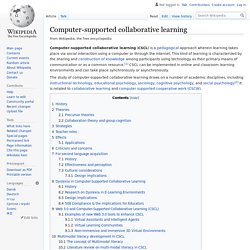

Virtual reality in primary education. General education[edit] Virtual reality (VR) can be used in numerous ways in an educational setting.

Augmenting reality[edit] Providing children with a way to immerse themselves into a context or situation can increase their understanding and provide a new perspective. In one study, Antonietti et al. (2000) found that giving children an in-depth virtual tour of a painting and letting them examine all aspects of the painting helped with their description and interpretation of the painting, when compared to a control group that studied the painting without the usage of VR.[2] Augmented reality books have been developed in order to provide a 3D rendition of the book, providing students with a different more synergetic way of learning. Virtual field trips[edit] In virtual field trips, students visit real-world places or educational simulations to experience different lessons. M-learning. Distance education using mobile device technology M-learning or mobile learning is "learning across multiple contexts, through social and content interactions, using personal electronic devices".[1]:page 4 A form of distance education, m-learners use mobile device educational technology at their convenient time.[2] M-learning technologies include handheld computers, MP3 players, notebooks, mobile phones and tablets.

M-learning focuses on the mobility of the learner, interacting with portable technologies. Using mobile tools for creating learning aids and materials becomes an important part of informal learning.[3] M-learning is convenient in that it is accessible from virtually anywhere. Background[edit] Mobile learning is the delivery of learning, education or learning support on mobile phones, PDAs or tablets.[7] New mobile technology, such as hand-held based devices, is playing a large role in redefining how people receive information. Internet scavenger hunt. An Internet scavenger hunt or CyberHunt is an educational lesson which introduces the Internet to students.

It is often used as tool for teaching students how to search the Internet and how to use the resources and information available on the Internet. It is an online activity in the form of a scavenger hunt that focuses on gathering information from web sites to answer questions or to support a concept on a particular theme or content area. The intent is to hunt for facts or information to add details for the answer to the question. The questions themselves may vary from the simple fact or statement to the more complex, depending upon the age and skill level of the student. By completing CyberHunts, students learn how to navigate a web site, scan a page for detailed information, and then apply the facts or ideas to the question. Although hunts frequently move from web site to web site, some direct a student's exploration of a single, content rich site.
Education and technology. One of the defining features of development today is the relationship between education and technology, stimulated by the spectacular growth in internet connectivity and mobile penetration.[1] We live in a connected world.

An estimated 40% of the world’s population now uses the internet and this number is growing at a remarkable rate.[2] While there are significant variations in internet connectivity among countries and regions, the number of households with such links in the global South has now overtaken those in the global North. Moreover, over 70% of mobile telephone subscriptions worldwide are now in the global South.[3] Five billion people are expected to go from no to full connectivity within the next twenty years.[4] However, there are still significant gaps among countries and regions, for example between urban and rural areas.
Limited broadband speed and lack of connectivity hamper access to knowledge, participation in society and economic development.[5] Computer-supported collaborative learning. Computer-supported collaborative learning (CSCL) is a pedagogical approach wherein learning takes place via social interaction using a computer or through the Internet.

This kind of learning is characterized by the sharing and construction of knowledge among participants using technology as their primary means of communication or as a common resource.[1] CSCL can be implemented in online and classroom learning environments and can take place synchronously or asynchronously. The study of computer-supported collaborative learning draws on a number of academic disciplines, including instructional technology, educational psychology, sociology, cognitive psychology, and social psychology.[2] It is related to collaborative learning and computer supported cooperative work (CSCW).
History[edit] The ijCSCL was established by the CSCL research community and ISLS. It began quarterly publication by Springer in 2006.